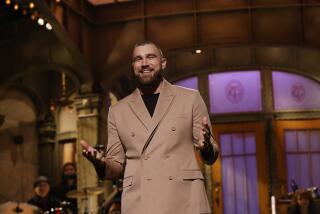Not All Super Bowl Ads Touchdowns
It’s been less than 24 hours since the Baltimore Ravens defeated the New York Giants, 34-7, in Super Bowl XXXV, but some advertisers already have shifted their focus to next year’s NFL championship game at New Orleans’ Super Dome.
Monster.com purchased its Super Bowl ad time on the day after last year’s game. Company founder and Chief Executive Jeff Taylor said before Sunday’s telecast that he’ll be back in 2002. “The Super Bowl is a critical part of our marketing and branding strategy.”
For the record:
12:00 a.m. Feb. 8, 2001 For the Record
Los Angeles Times Thursday February 8, 2001 Home Edition Business Part C Page 3 Financial Desk 1 inches; 25 words Type of Material: Correction
Super Bowl--A Jan. 29 story in the Business section about Super Bowl advertising misspelled Pamplona, the name of a Spanish city that is home to the annual running of the bulls.
Taylor couldn’t gauge the immediate impact of Monster.com ads that ran during Sunday’s game.
But there were more losers than winners overall, according to a group of USC business school graduate students who watched Sunday’s game as part of a sports marketing class.
“There’s nothing there that I’ll be talking about during the coming week,” said Natasha Jones, 26, from Sacramento, about the more than 50 ads that aired.
Her pick of the commercial litter: an E-Trade spot that poked fun at the rash of failed dot-coms with a quick look at a worn sock puppet used by now-defunct Pets.com. A year ago, Pets.com had one of the more memorable ads of Super Bowl XXXIV.
“Usually, Anheuser-Busch has something that really stands out, but I didn’t see it this year,” said Kimberly Ishihara, 27, also from Sacramento. “Except for the E-Trade ad, there wasn’t anything people will be talking about.”
Companies spent a total of $150 million for ads during the game, which usually draws as many as 130 million viewers. CBS charged an average of $2.2 million for a 30-second spot.
Students were unimpressed with advertising from Accenture, Cingular Wireless and Verizon Wireless, whose spots were designed to promote their new corporate names.
“I don’t know what’s going on there,” said Ara Weiss, 27, after watching an Accenture spot that showed a moving automobile. “For the first 20 seconds, it seemed to be a car commercial. I don’t know why they’re not saying their name more often.”
When a subsequent spot failed to immediately identify who had paid for the ad, 28-year-old Vincent Jones pegged it as “another of those Accenture commercials.”
The spots that did play well with the students were Hollywood’s parade of sales pitches for such upcoming feature films as “Hannibal” and “Tomb Raider.”
The graduate students embraced the need for anti-smoking spots but questioned whether serious messages belong in the broadcast. They also frowned on a Monster.com ad that focused on a corpse in a coffin.
The Super Bowl XXXV advertising blitz offered something for everyone, from Snickers’ new Cruncher candy bar to Johnson & Johnson and Merck’s new Pepcid Complete heartburn remedy.
Levi Strauss & Co. and Volkswagen of America made their Super Bowl debuts Sunday. Longtime advertisers Anheuser-Busch and Pepsi-Cola also ran a hefty number of spots.
As usually happens during the advertising industry’s big game, not everything was as it seemed. Instead of bulls stampeding through the streets of Pamploma, EDS Corp. gave viewers squirrels scampering through the streets of a small Spanish town called Pedraza.
Weiss, who described the broadcast as the “debutantes’ ball,” said the game served its purpose as a launching pad for advertising campaigns.
The broadcast “is a starting point, but that’s all it is,” agreed Jeff Blake, president of worldwide marketing and distribution for Columbia TriStar Motion Picture Group, which used a 30-second spot in the fourth quarter to promote the upcoming action film, “A Knight’s Tale.”
David Carter, a sports marketing consultant who teaches the Business of Sports class at USC’s graduate school, questions whether advertisers who spent $150 million for Super Bowl spots in CBS’ broadcast from Tampa, Fla., got their money’s worth.
“This was the least memorable batch of commercials in memory as far as creativity,” Carter said.
Number crunchers immediately set to work on calculating the effectiveness of ads shown during the Super Bowl. SWR Worldwide, an opinion and market research firm, equipped a dozen consumers at a sports bar in New York City with monitors to gauge their reactions to spots aired.
“The wireless remotes monitor reactions on a moment-by-moment basis during the game,” said SWR Worldwide Vice President John Della Volte.
Computer software produces an EKG-like graph that’s overlaid on the commercials.
“If they like a spot, they move the dial up toward 100. If it’s a negative reaction, they go back toward zero,” Della Volte said. “Companies spend millions of dollars per spot, and we think this is the best way to find out what persuades and moves Americans.”
Results of SWR’s survey will be made public this morning on ABC’s “Good Morning America” program.
CBS on Saturday night institutionalized Super Bowl commercials in a one-hour show that featured many of the annual broadcast’s most popular commercials. A 1980 Coke spot featuring former Pittsburgh Steeler Joe Greene beat Apple’s memorable 1984 Orwellian spot as the best Super Bowl commercial.
More to Read
Inside the business of entertainment
The Wide Shot brings you news, analysis and insights on everything from streaming wars to production — and what it all means for the future.
You may occasionally receive promotional content from the Los Angeles Times.










